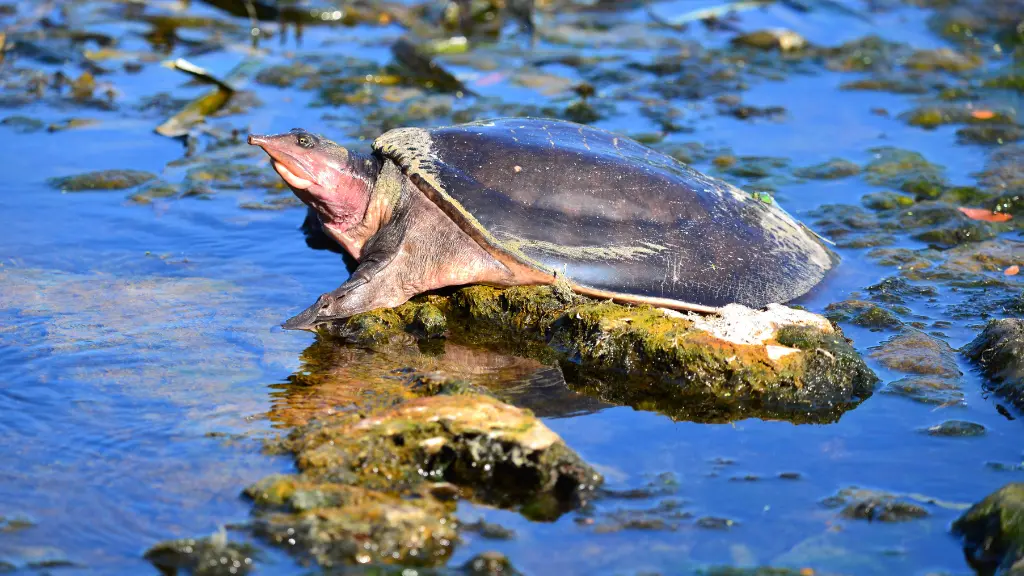Softshell turtles, with their distinctive pancake-like shells and elongated snouts, have captured the curiosity of many reptile enthusiasts. But beyond their peculiar appearance, a common question lingers: are softshell turtles friendly?

As with any creature, it’s essential to understand its natural behaviours, temperament, and environmental needs before bringing one into your home or encountering one in the wild.
In this blog post, we’ll dive into the world of softshell turtles, exploring their personalities, the factors that influence their behaviour, and what to expect when interacting with these fascinating reptiles.
By the end of this post, you’ll understand whether the term “friendly” is a fitting description for these unique creatures. So, let’s set off on this turtle-y excellent adventure!
Softshell turtle species
There are over 100 species of softshell turtles, and they can be found on every continent except Antarctica. Softshell turtles are unique in that their shells are soft and leathery, unlike other turtle species’ tough, bony shells. This makes them more agile on land and allows them to burrow underground.
Despite their name, not all softshell turtles are friendly. Many species are quite aggressive, especially when startled or threatened.
However, a few species are known to be relatively tame, such as the spiny softshell turtle (Trachemys scripta elegans) and the Florida softshell turtle (Apalone ferox). If you’re looking for a friendly softshell turtle as a pet, these two species are your best bet.
Understanding softshell turtle behaviour
Softshell turtles are interesting creatures with unique behaviours. Here are a few things to know about them:
1. Natural instincts:
Softshell turtles are territorial and can be aggressive, so it is best to provide them with plenty of space for them to feel comfortable and safe.
2. Activity Levels:
Softshell turtles are semi-aquatic animals, meaning they spend part of their time on land and in the water. During the day, they may choose to bask on land or swim around in bodies of water. At night, they tend to burrow into soft mud or sandy areas on the shore and rest until morning.
3. Diet:
Softshell turtles are omnivores with a varied diet consisting of insects, plants, fish, and other small organisms such as molluscs. They also appreciate eating a variety of live food items like earthworms, crickets, and snails.
4. Temperature Requirements:
Softshell turtles do best in warm temperatures ranging from 70°F – 85°F with access to land and water habitats. Additionally, providing your turtle with multiple basking spots during the day will help regulate its body temperature better.
5. Interaction with Humans:
Softshell turtles are not used to being handled by humans and can become stressed if disturbed too much. It is best to observe these creatures from a distance and provide an appropriate environment for them to live in.
Are Softshell Turtles Friendly? Decoding Their Temperament
In general, softshell turtles are not considered to be friendly animals. They are often solitary creatures that do not interact much with other animals or humans.
Softshell turtles can be friendly when properly socialized, but their temperament varies depending on the individual turtle and the circumstances. They are not naturally aggressive but may become defensive if they feel threatened.
However, there are some exceptions to this rule. Some softshell turtles can be quite tame and even affectionate towards their owners. These turtles typically have a lot of personality and can be fun to watch and interact with.
What to Consider in Caring for Softshell Turtles?
When it comes to caring for softshell turtles, there are a few things you need to take into consideration.
1. Proper Habitat: Provide a large, well-filtered aquarium with water and land areas. Ensure the water is clean and maintained at an appropriate temperature (typically 75-80°F).
2. Substrate: Use a soft, sandy substrate to prevent shell damage, as softshell turtles have sensitive plastrons.
3. Basking Area: Create a basking area with a heat lamp and UVB light to help regulate body temperature and promote shell health.
4. Handling: Minimize handling, as softshell turtles can become stressed and may display aggressive behaviours when threatened. Interaction should be limited to necessary care and maintenance.
5. Enrichment: Provide hiding spots and enrichment items to promote natural behaviours and keep your turtle mentally stimulated.
6. Safety: Ensure the enclosure is secure to prevent escape and keep other household pets away from the turtle’s habitat.
7. Learn About Species: Research the specific needs of your turtle’s species, as care requirements may vary.
How to Make a Softshell Turtle Feel Loved and Secure?
Providing a loving and secure home is essential when it comes to keeping your softshell turtle happy and healthy. Here are some tips on how to make your softshell turtle feel loved and secure:
- Create a warm and humid environment. Softshell turtles need a warm and humid environment to thrive. You can create this environment by using a heat lamp and regularly misting the enclosure with water.
- Provide plenty of hiding spots. Hiding spots are important for softshell turtles as they provide a place to feel safe and secure. Be sure to include both land and water hiding spots in the enclosure.
- Give your turtle regular handling time. Handling time is important for bonding with your softshell turtle. Be sure to wash your hands before and after handling, and offer gentle strokes and scratches under the chin to show affection.
- Keep the enclosure clean. Regularly cleaning your turtle’s enclosure is important for keeping it healthy and disease-free. 5. Provide a healthy diet. A balanced and nutrient-rich diet is essential for keeping your softshell turtle happy and healthy. Be sure to offer a variety of fruits, vegetables, and other turtle-safe foods.
- Offer enrichment toys. Enrichment toys are a great way to keep your softshell turtle stimulated and engaged. Offer items such as floating/sinking logs, tunnels or mazes, or toys that can be moved around in the enclosure.
Tips for creating a friendly environment for softshell turtles:
It’s important to remember that softshell turtles are wild animals, which can be unpredictable. With that said, there are some steps you can take to create a friendly environment for softshell turtles:
- Provide plenty of hiding places. Softshell turtles are naturally shy and will feel more comfortable if they have plenty of places to hide. This can be accomplished by providing rocks, logs, or other hiding spots in their enclosure.
- Give them plenty of space to swim. Softshell turtles are strong swimmers and need plenty of room to move around. A large water area is essential for their well-being.
- Feed them a variety of foods. Softshell turtles are omnivorous and need a diet including plant and animal matter. Various pellets, vegetables, and live food will help keep them healthy and happy.
- Provide a basking area. Like all turtles, softshells need a place to dry off and get out of the water. A floating platform or basking area is a great way to give them that opportunity.
- Keep their enclosure clean. Softshell turtles are more sensitive to water quality than other species, so keeping their tank and filter cleaned regularly is important.
- Minimize stress factors. Loud noises, bright lights, and sudden movements can stress softshell turtles. It’s important to keep things as quiet and peaceful as possible in their environment.
By following these tips, you should be able to create a friendly and welcoming environment for your softshell turtle.
Conclusion:
If you’re looking for a friendly turtle to keep as a pet, a softshell turtle is not the right choice. These turtles are notoriously grumpy and aggressive, and they’re not known for being particularly fond of humans.
However, if you appreciate their independent nature and don’t mind getting bitten occasionally, a softshell turtle might be the perfect pet.
I hope you have found the information in this article helpful when considering keeping a softshell turtle as a pet. Remember that they require specialized care, so it’s important to do your research before adopting one.


1 thought on “Are Softshell Turtles Friendly? (Discovering the Intriguing Nature of These Unique)”